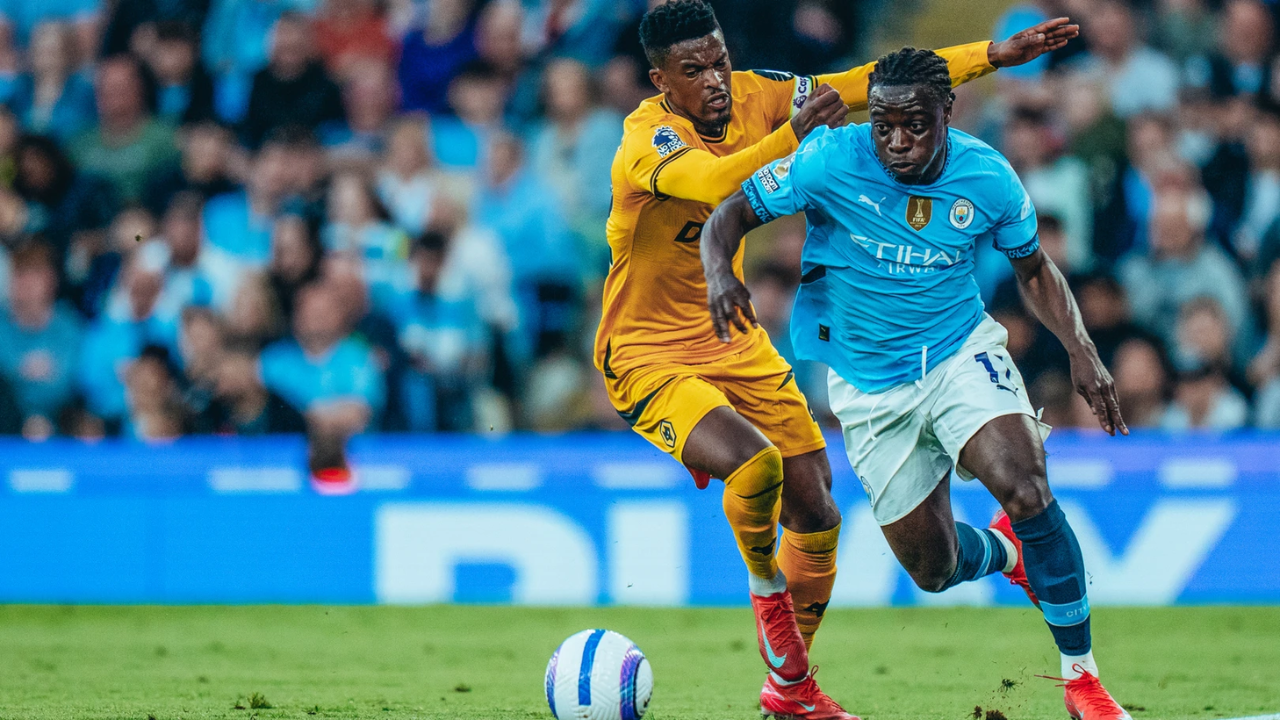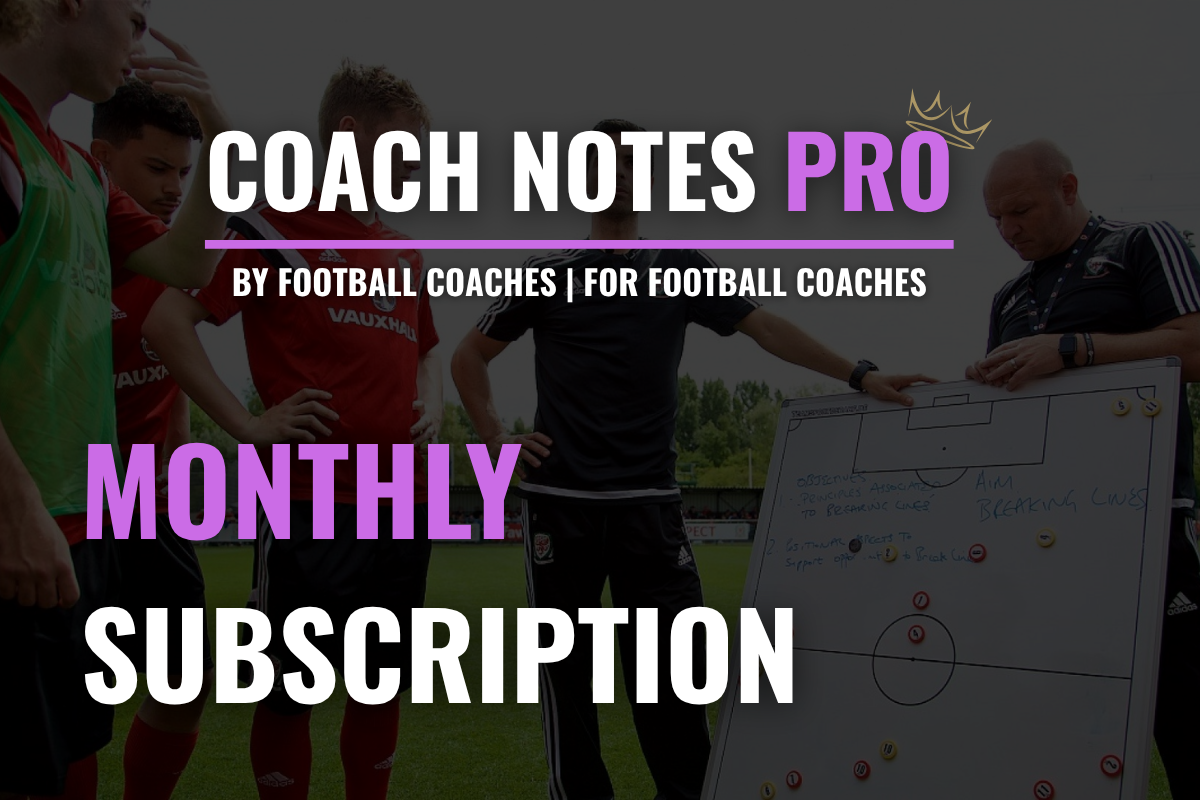
Wingers/Inside Forward Specific Coaching
This section features 8 key areas essential to developing wingers & inside forwards, each with tailored coaching tips and position-specific drills. Every skill is broken down to help strikers make better decisions and execute with confidence in 1v1 situations.
1v1 Dribbling Coaching Tips
✅ Start with Body Shape & First Touch
A winger's body shape before engaging the defender is crucial. Teach players to adopt a side-on stance with knees slightly bent, ready to explode in either direction. The first touch must be purposeful, either to engage the defender or move into space. Use cone-to-cone 1v1 gates where the attacker’s first touch determines the outcome of the duel.
✅ Vary Tempo and Rhythm to Unsettle Defenders
Successful 1v1 dribbling relies less on constant speed and more on tempo variation. Teach players to slow down as they approach the defender, then accelerate explosively to beat them. Encourage “stop-start” movements and rhythm changes through disguised feints, stepovers, or shoulder drops. Design drills that reward changes in pace leading to success.
✅ Use Both Feet and Multiple Exit Options
Limit predictability. Train players to dribble comfortably with both feet, allowing them to go inside or outside depending on the defender’s positioning. Incorporate repetition of 1v1s with multiple exit gates (inside, outside, underlap) to improve decision-making and force the defender to react, not anticipate.
✅ Scan Before the Duel – Beat With Purpose
Teach wingers to scan before receiving so they know whether to isolate the full-back, combine with a teammate, or drive into space. Beating a defender must serve a purpose: create space for a cross, shot, or cutback. Use scenario-based drills where dribbling must lead to a final action within 3–5 seconds.
✅ Engage the Defender’s Front Foot
A classic 1v1 principle is to target the front foot of the defender — forcing them to commit and creating space to attack the opposite side. Encourage wingers to approach close enough to draw pressure, then use a sharp movement or skill to exploit the defender’s momentum. Drills should simulate real spacing and time pressure (e.g. 1v1s with recovery defenders).
Crossing Coaching Tips
✅ Scan Early for Targets Before Delivering
Encourage wingers to lift their head early before delivering the ball — especially after beating a defender. Players should develop the habit of scanning the box before committing to a cross, identifying where strikers or arriving midfielders are positioned. Use drills with mannequins or live targets in the box to simulate varying crossing decisions.
✅ Deliver Based on the Situation
Coach players to choose the appropriate type of delivery based on the phase of play. Whipped crosses for fast-paced attacks, lofted deliveries when targets are unmarked, and cutbacks when defenders are recovering deep. Reinforce decision-making with scenario-based crossing zones (byline, early cross, underlap) and reward variation.
✅ Prioritise Delivery Zones Over Defenders
Target high-probability areas — such as the penalty spot, six-yard line, or cutback zone — rather than reacting solely to defenders’ positions. Teach wingers that crosses into these zones often produce rebounds, deflections, or finishing opportunities even if not perfect. Use unopposed drills first, then progress to pressure-based situations.
✅ Cross at Speed and in Stride
Players often lose quality by over-preparing the cross. Emphasise delivering while in motion, especially in transition moments. Practice crossing drills with a time constraint (e.g. deliver within two touches after receiving the ball) to replicate match tempo and improve efficiency under pressure.
✅ Develop Both Feet for Versatility
Inside forwards especially must be able to cut in and cross with their weaker foot or drive to the byline with their strong side. Repetition is key: isolate crossing drills for both feet, with varying starting angles (wide, half-space, deeper positions). This helps players become less predictable and more adaptable against different defensive setups.
Cutting Inside Coaching Tips
✅ Create Separation with the First Touch or Deception
Encourage players to use their first touch to shift the ball diagonally inside, creating a direct line toward goal or central play. If space is tight, teach them to use body feints or shoulder drops to unbalance the defender before making the inside drive.
✅ Scan Before and During the Drive
Wingers must scan before receiving to assess the positioning of defenders, midfield traffic, and the goalkeeper. Once inside, continue scanning for cutback opportunities, shooting windows, or overlapping runs. This improves awareness and ensures the drive has purpose.
✅ Attack with Purpose and Use Speed Variations
Coach players to change pace mid-drive — slowing to size up the defender, then accelerating through the gap. Remind them that cutting inside should lead to a decision zone: either to shoot, slip a pass, or combine. Use drills with time limits to reinforce fast, purposeful action.
✅ Choose the Right End Product
Once inside, players should decide early whether to shoot, combine, or switch. If space opens centrally, drive towards the top of the box and shoot with power or curl. If defended tightly, slip in a forward or play a quick 1-2. Use scenario drills where different end products are rewarded based on decision-making.
✅ Practise from Both Sides
Train wingers to cut inside from both the left and right flanks, developing confidence to shoot or pass with either foot. This increases unpredictability and adaptability, especially in systems where wide players rotate or swap sides frequently.
Off Ball Movement Coaching Tips
✅ Recognise Cues for Movement
Teach players to scan the ball carrier’s body shape and recognise cues for movement — such as a midfielder receiving on the half-turn or a full-back preparing a switch. Wingers should start their runs just as the passer is setting up, not after the ball is played. Timing is essential to beat defensive lines and avoid offside.
✅ Vary Runs to Unsettle Defenders
Encourage wingers to mix up their movement patterns: wide-to-central runs, curved runs in behind, diagonal runs across centre-backs, and decoy runs to drag defenders away. Repetition of the same run makes defending easier — variety keeps the back line guessing and creates space for teammates.
✅ Use Blind-Side Positioning
Coach players to initiate runs from the blind side of defenders, where they are less visible and harder to track. Wingers should operate on the shoulder of the last defender, stepping into space as the ball is played. This positioning gives a split-second advantage when attacking the box or running in behind.
✅ Time Box Arrivals
It’s not just about speed — it’s about arriving when the ball does. Train players to judge when to hold their run, delay, or accelerate depending on the phase of play. For example, arriving late on a cutback can leave them unmarked in Zone 14, while early arrivals often get picked up or caught offside.
✅ Communicate and Coordinate with Teammates
Movement must complement the team’s structure. Wingers should coordinate their runs with the positioning of full-backs, strikers, and attacking midfielders. Clear communication (verbal or visual) ensures spacing is balanced and overloads are created in the right zones.
Playing in Wide Areas Coaching Tips
✅ Maintain Optimal Width
Encourage players to stay wide and high when the team is in possession, especially in the build-up or when playing against compact defences. This positioning creates maximum space inside for teammates and stretches the back line, increasing the chance of 1v1 opportunities or isolations.
✅ Recognise Isolation vs Overload Moments
Train wingers to read the game and identify whether they are isolated (1v1 or 1v2) or involved in a wide overload (e.g. overlapping full-back, supporting midfielder). In isolation, they should prepare to go direct and attack their defender. In overloads, quick combinations (wall passes, underlaps) can dismantle defensive shapes.
✅ Receive on the Half-Turn or Facing Forward
Position the body to receive facing forward or side-on, allowing for quick decision-making once the ball arrives. Encourage wingers to receive on the back foot when possible and avoid receiving with their back to the sideline, which limits options and invites pressure.
✅ Use the Touchline as a Guide, Not a Trap
While maintaining width, wingers should avoid getting pinned on the touchline. Teach players to keep the ball just inside the wide channel, where they have room to attack both inside and down the line. Intelligent footwork and ball positioning can prevent defenders from forcing them into tight spaces.
✅ Scan Before Receiving and Shape the First Touch
Players should scan for pressure and options before the ball arrives, then shape their first touch to either attack space, combine, or set up a cross. The first touch sets the tempo of the action — it should be purposeful and aligned with the decision already made from scanning.
Counter Attack Threat Coaching Tips
✅ Be Direct With Runs
Encourage players to attack space immediately upon the turnover — wide players should sprint into advanced positions before the opposition can recover. This vertical movement pins back defenders and creates immediate options for the ball carrier. Decision-making comes once the run has stretched the play.
✅ Start from Deep & Wide
Wingers should position themselves slightly deeper and wider in defensive phases to create a bigger launch zone. This allows them to receive on the move with space to exploit and forces full-backs into difficult recovery runs across their body.
✅ Angle Runs to Attack Gaps
Coach players to bend their runs — cutting inside behind full-backs or into the channel between centre-back and full-back — depending on where the space opens. These runs make it difficult for defenders to track and create clear through-ball angles for the passer.
✅ Commit with Directness but Stay Composed
Wingers should be aggressive and direct in carrying the ball, but avoid rushing decisions. Emphasise scanning during the run — assessing whether to drive to goal, slide a pass across, or hold for support. Confidence in these moments can determine the quality of the final action.
✅ Support Runs Create Layered Threats
Reinforce that not every counter-attack ends with the winger shooting. Sometimes, their movement draws defenders to free up others. Train wingers to either carry the ball at pace or act as a decoy or wide outlet, with well-timed cutbacks or support options arriving from midfield.
Pressing & Recovery Coaching Tips
✅ Understand the Pressing Trigger
Train players to recognise clear pressing cues – such as poor first touches, back passes, sideways passes under pressure, or when the opposition has limited support options. Pressing should be intentional and collective, not based on individual instinct alone.
✅ Press from the Correct Angle
Wingers must approach opponents at an angle that forces play into predictable areas – usually towards the touchline or into a pressing trap. The goal is not just to win the ball, but to cut off passing lanes and shape the play. Avoid pressing head-on unless support is behind.
✅ Stay Connected to the Line Behind
Wingers pressing too high or too deep create gaps. Teach players to align themselves with the midfield line behind, maintaining compactness in the team shape. This supports mid-block organisation and prevents the opposition from playing through wide channels.
✅ Immediate Recovery Reaction
Upon losing the ball, wingers must react instantly – either by counter-pressing to regain possession or sprinting back into shape. The first 5 seconds after loss are key. Build habits through transition drills where players are rewarded for fast recovery runs.
✅ Coordinate with Full-Backs and Inside Players
Defensive success depends on coordination with teammates. Wingers should know when to press high with the striker, when to drop and block passing lanes, and when to cover an overlapping full-back. Use pattern-based pressing drills to build understanding of these partnerships.
Decision Making Coaching Tips
✅ Head Up Before and After the First Touch
Train players to scan both before and immediately after receiving the ball. This allows them to recognise the position of defenders, the goalkeeper, and teammates. A winger with constant visual information is more likely to make the correct decision — whether to dribble, pass, or shoot.
✅ Match the Action to the Scenario
Help players understand when to take on a defender 1v1, when to combine, or when to release the ball early. For example, in tight spaces with support, a wall pass may be more effective than forcing a dribble. Use video clips and scenario-based drills to train this situational awareness.
✅ Recognise Goalkeeper & Defender Body Cues
In shooting scenarios, wingers must be taught to read the goalkeeper's positioning and defender’s body shape. If the goalkeeper is near post, shoot across goal. If the defender is square, drive at the space. Decision-making under pressure improves when players learn to read these small visual cues.
✅ Be Composed Inside the Box
When arriving in the box, encourage players not to panic. Quick reactions do not mean rushed decisions. Work on controlled finishes, fake shots to commit defenders or the keeper, and intelligent touches to open angles. Delay the action if needed to improve the outcome.
✅ Build Confidence Through Repetition & Variation
Expose players to a range of final third scenarios: shooting, cutting back, sliding passes, or pulling out to reset. Use drills that vary decisions each time – for example, a winger receiving a pass where they must choose to shoot, cross, or combine depending on teammate movement and pressure.

































